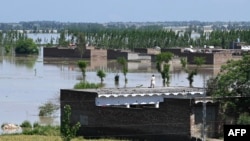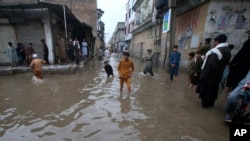Authorities in Pakistan and Afghanistan said Tuesday that intense unseasonal rainfall, lightning and floods across both neighboring countries had killed at least 100 people over the past several days.
A spokesman for the Afghanistan National Disaster Management Authority said floods had caused human and material losses in 13 of the country’s 34 provinces.
Janan Saiq reported that the disaster resulted in nearly 50 fatalities, dozens of injuries, and the loss of hundreds of livestock.
The United Nations Office for the Coordination of Humanitarian Affairs in Afghanistan said Tuesday that the recent heavy rains and floods have affected more than 1,200 families and damaged almost 1,000 houses and at least 25,000 hectares of agricultural land.
The statement noted that the U.N. and partners “are assessing the impact and related needs and providing assistance.”
The Afghan meteorological agency has predicted that more heavy rainfall is expected in most provinces.
Poverty-stricken Afghanistan has been reeling from the devastation of years of conflict and natural disasters, including floods, droughts and earthquakes.
Last October, a series of earthquakes rattled western Herat and surrounding provinces, killing around 1,500 people.
Devastation in Pakistan
On Tuesday, Pakistan's federal and provincial authorities reported that over 50 people have died due to heavy rains, flash floods, lightning, storms and landslides.
Most of the fatalities occurred in northwestern Khyber Pakhtunkhwa province, which borders Afghanistan, and central Punjab province. Officials said that at least 42 people were killed in both provinces, and many more were injured.
Southwestern Baluchistan province and areas elsewhere in Pakistan have reported the rest of the casualties and losses to houses, as well as agricultural land.
The National Disaster Management Authority has advised emergency services to remain on high alert, as another spell of heavy rains is expected later this week.
Officials have blamed climate change for the unusually heavy rains in Pakistan.
Although the South Asian nation, with an estimated 250 million population, contributes less than 1% to global greenhouse gas emissions, it is listed as one of the most vulnerable countries to the impacts of climate change.
Pakistan experienced severe flooding in 2022 due to seasonal heavy monsoon rainfall and floods, resulting in at least 1,700 deaths, affecting 33 million people and submerging approximately one-third of the country.
After visiting flood-hit areas in 2022, U.N. Secretary-General Antonio Guterres said Pakistanis were “facing a monsoon on steroids — the relentless impact of epochal levels of rain and flooding.”
Guterres criticized a lack of climate action, despite rising global emissions of greenhouse gases.
“Let’s stop sleepwalking towards the destruction of our planet by climate change. Today, it’s Pakistan. Tomorrow, it could be your country," he said.





